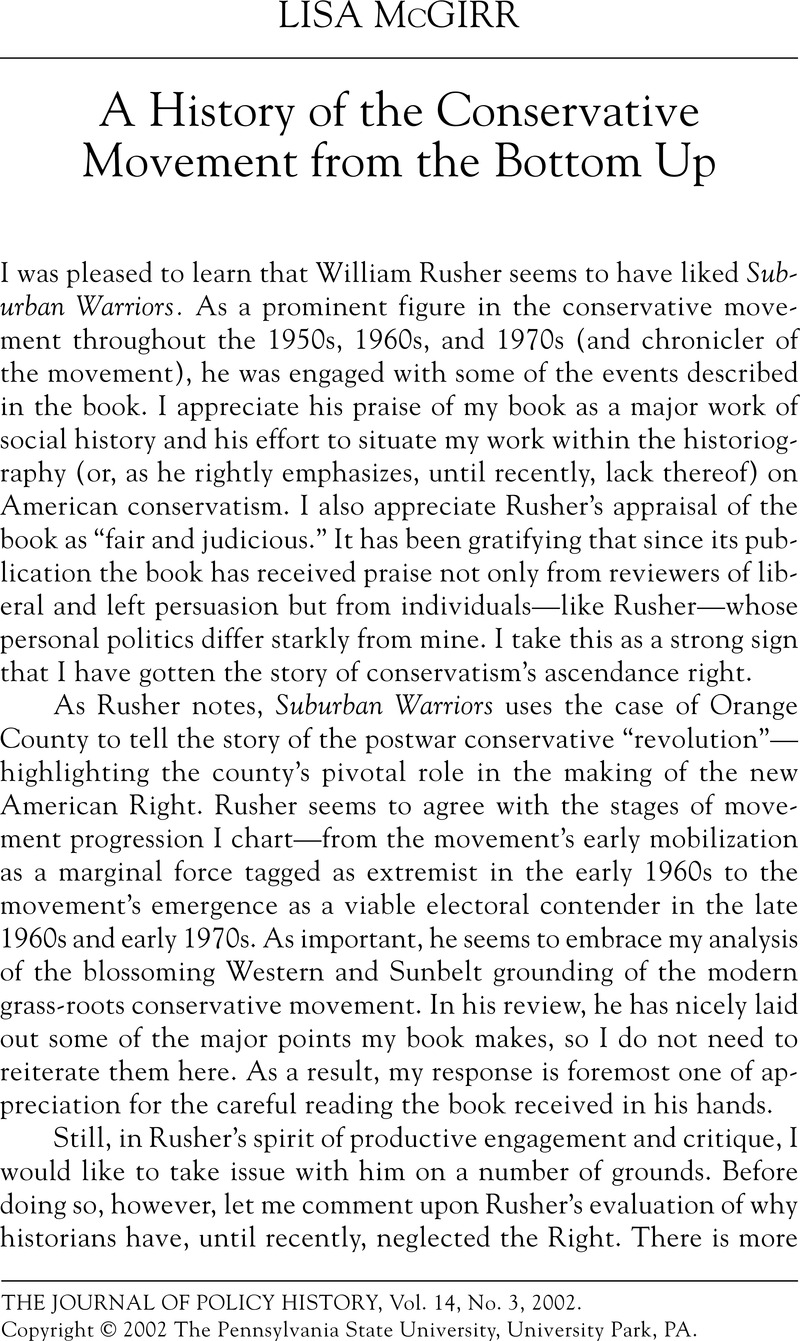Published online by Cambridge University Press: 27 April 2009

1. Kazin, Michael, “The Grass-Roots Right: New Histories of U.S. Conservatism in the Twentieth Century,” American Historical Review 97 (02 1992): 136–155.CrossRefGoogle Scholar See also Moore, Leonard, “Good Old-Fashioned New Social History and the Twentieth-Century American Right,” Reviews in American History 24 (1996): 555–573.CrossRefGoogle Scholar
2. Brinkley, Alan, “The Problem of American Conservatism,” American Historical Review 99 (04 1994): 414.CrossRefGoogle Scholar
3. An attenuated list of some of these studies includes Nash, George H., The Conservative Intellectual Movement in America Since 1945 (New York, 1976)Google Scholar; Allitt, Patrick, Catholic Intellectuals and Conservative Politics in America, 1950–1985 (Ithaca, 1993)Google Scholar; Schoenwald, Jonathan, A Time for Choosing: The Rise of Modern American Conservatism (New York, 2001)Google Scholar; Perlstein, Rick, Before the Storm: Barry Goldwater and the Unmaking of the American Consensus (New York, 2001)Google Scholar; Brennan, Mary C., Turning Right in the Sixties: The Conservative Capture of the GOP (Chapel Hill, 1995)Google Scholar; Andrew, John A., The Other Side of the Sixties: The Young Americans for Freedom and the Rise of Conservative Politics (New Brunswick, N.J., 1997)Google Scholar; Schneider, Gregory L., Cadres for Conservatism: Young Americans for Freedom and the Rise of the Contemporary Right (New York, 1999)Google Scholar; Goldberg, Robert, Barry Goldwater (New Haven, 1995)Google Scholar; Carter, Dan T., The Politics of Rage: George Wallace, the Origins of the New Conservatism, and the Transformation of American Politics (New York, 1995)Google Scholar; Miles, Michael W., The Odyssey of the American Right (New York, 1980)Google Scholar; Reinhard, David, The Republican Right Since 1945 (Lexington, Ky., 1983)Google Scholar; Hodgson, Godfrey, The World Turned Right Side Up: A History of the Conservative Ascendancy in America (Boston, 1996).Google ScholarDionne, E. J. Jr., Why Americans Hate Politics (New York, 1991)Google Scholar; Edsall, Thomas Byrne and Edsall, Mary D., Chain Reaction: The Impact of Race, Rights, and Taxes on American Politics (New York, 1991)Google Scholar; Diamond, Sara, Roads to Dominion: Right-Wing Movements and Political Power in the United States (New York, 1994)Google Scholar; and Himmelstein, Jerome L., To the Right: The Transformation of American Conservatism (Berkeley and Los Angeles, 1990.)Google Scholar
4. Brinkley, Alan, “The Problem of American Conservatism,” American Historical Review 99 (04 1994): 410.CrossRefGoogle Scholar
5. These include, for example, places such as Fort Worth and the northeast suburbs of Dallas, Texas; Scottsdale and Maricopa County, Arizona; and Cobb and northern Dekalb Counties, Georgia.
6. On the West Virginia textbook struggle, see Martin, William, With God on Our Side: The Rise of the Religious Right in America (New York, 1996).Google Scholar For the battle against gay rights in an Oregon community, see Stein, Arlene, The Stranger Next Door: The Story of a Small Community's Battle over Sex, Faith, and Civil Rights (Boston, 2001).Google Scholar
7. New York Times Magazine, 17 September 1961, quoted in Kolkey, Jonathan Martin, The New Right, 1960–1968, with epilogue, 1969–1980 (Washington, D.C., 1983), 188.Google Scholar
8. Memorandum to “All Concerned” from Marvin Liebman, 16 January 1962, Marvin Liebman Papers, Hoover Institution on War, Revolution, and Peace.
9. Roche, Jeff, “Cowboy Conservatism: High Plains Politics, 1933–1972” (Ph.D. diss., University of New Mexico, 2001).Google Scholar